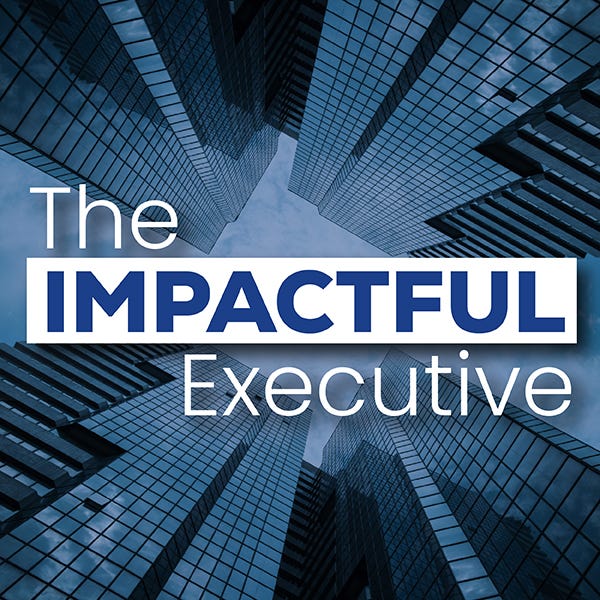Impactful Element: Innovation
Impactful "Innovation": proactive, customer-centric pursuit of novel business solutions.
Welcome to The Impactful Executive!
Read time: 3 min
The Impactful Executive newsletter uses the Impactful Framework as a loosely structured sequence of nine elements, each with evidence-based practices and tactics for executives, managers, advisors, and their teams.
See the reference article below, if needed, before this Element deep dive.
The Impactful Framework
Evidence-based practices for executive teams.
“Strategy without tactics is the slowest route to victory. Tactics without strategy are the noise before defeat.”
Sun Tzu
Impactful Element Defined: Innovation
"Companies need to keep looking forward, always staying on their toes, ready for the next wave of innovation."
Clayton Christensen
"Innovation is taking two things that already exist and putting them together in a new way."
Tom Freston
The “Innovation” element is defined as:
Innovation is the continuous search for new ideas, processes, goods, or services that allow a company to remain competitive and responsive to market swings.
It necessitates keeping abreast of industry developments and prospective disruptions and comprehending competition in the context of market collaboration opportunities ("competition"). This technique entails carefully balancing incremental gains with transformational, game-changing upgrades.
A focus on the client is critical to innovation success, as it drives the development of new products, services, or processes by knowing their wants and preferences.
Furthermore, in an environment of cross-functional collaboration, innovation thrives.
Continually scanning the environment for changes and disruptions can help the company to anticipate shifts and respond proactively.
"Every once in a while, a new technology, an old problem, and a big idea turn into an innovation."
Dean Kamen
"The heart and soul of a company is creativity and innovation."
Robert Iger
Impactful Element Practices: Innovation
The following is a sample selection of Impactful Innovation Practices:
Be Customer-Centric: This practice involves deeply understanding customer needs and pain points. For example, LEGO uses customer feedback to develop new sets, sometimes involving customers in the design process. Amazon's "Day 1" philosophy, which focuses on agility and customer obsession, is a prime example of customer-centric practice.
Understand Your Market: Organisations benefit from encouraging a complete understanding of market dynamics, trends, and competitor actions. Under Elon Musk's leadership, Tesla has successfully extrapolated market trends to innovate and dominate the electric car market.
Adapt to Market Changes: Two interrelated components of this include (A) dynamic resource allocation, where flexibility can increase innovation output; and (B) agile ways of working, allowing quick adaptation. The famous case of the once-dominant video rental company, Blockbuster exemplifies the necessity for adaptation. Its inability to adapt to market changes related to streaming services led to its downfall as streaming services such as Netflix took over the market.
Invest in Research and Development (R&D): Allocating resources towards R&D can lead to new product development and increased firm productivity. Samsung Electronics is known for its heavy R&D investments, driving the development of innovative products across a wide variety of products, from electronics, shipbuilding, and construction, to financial services and hospitality.
Create Space to Experiment and Fail: Encouraging employees to take risks can boost innovation, cultivating an environment where employees feel empowered to experiment. This practice means accepting, encouraging, and celebrating trial and error. Jeff Bezos, Amazon's CEO, emphasises the importance of failure as an integral part of the innovation process. This approach has allowed Amazon to explore bold ideas and continue to innovate with successes such as AWS, one-click purchasing, Audible, and Prime. At Dyson, James Dyson famously made 5,127 prototypes of his vacuum before perfecting the first commercial model.
Implement Intrapreneurship Programs: These programs can enhance product innovation and creativity. Furthermore, recognising and rewarding innovative behaviour can increase motivation and morale. LinkedIn's [in]cubator program allows employees to develop their own ideas, promoting a culture of intrapreneurship. At 3M, employees are recognised for their innovative efforts with programs such as the "Golden Step" awards, which recognise teams that have made significant contributions to commercially successful products.
Promote External Collaboration: Firms engaging in strategic alliances can accelerate new product revenue. Fostering networks of innovative thinkers creates a web of interconnected ideas and resources. NASA's partnerships with private companies like SpaceX and Blue Origin exemplify successful external collaboration. The collaboration between Starbucks and Spotify, combining music with the coffee shop experience, is another surprising example.
"Business has only two functions - marketing and innovation."
Milan Kundera
"There’s a way to do it better - find it."
Thomas Edison
In subsequent newsletters, we will deep-dive into many specific practices outlined above.
The Impactful Executive’s Purpose
Reminder: this newsletter pursues high-impact practices and tactics across each element to share fact-based, usable, and (hopefully) surprising insights.
It takes deliberate and sustained effort to drive organizational greatness. The Impactful Executive aims to make this greatness far more reachable.
In Jim Collins’ words, "Greatness is not a function of circumstance. Greatness, it turns out, is largely a matter of conscious choice and discipline."
Impactfully yours,
The Impactful Executive Team
This post is public. Feel free to subscribe to and share the newsletter below.


